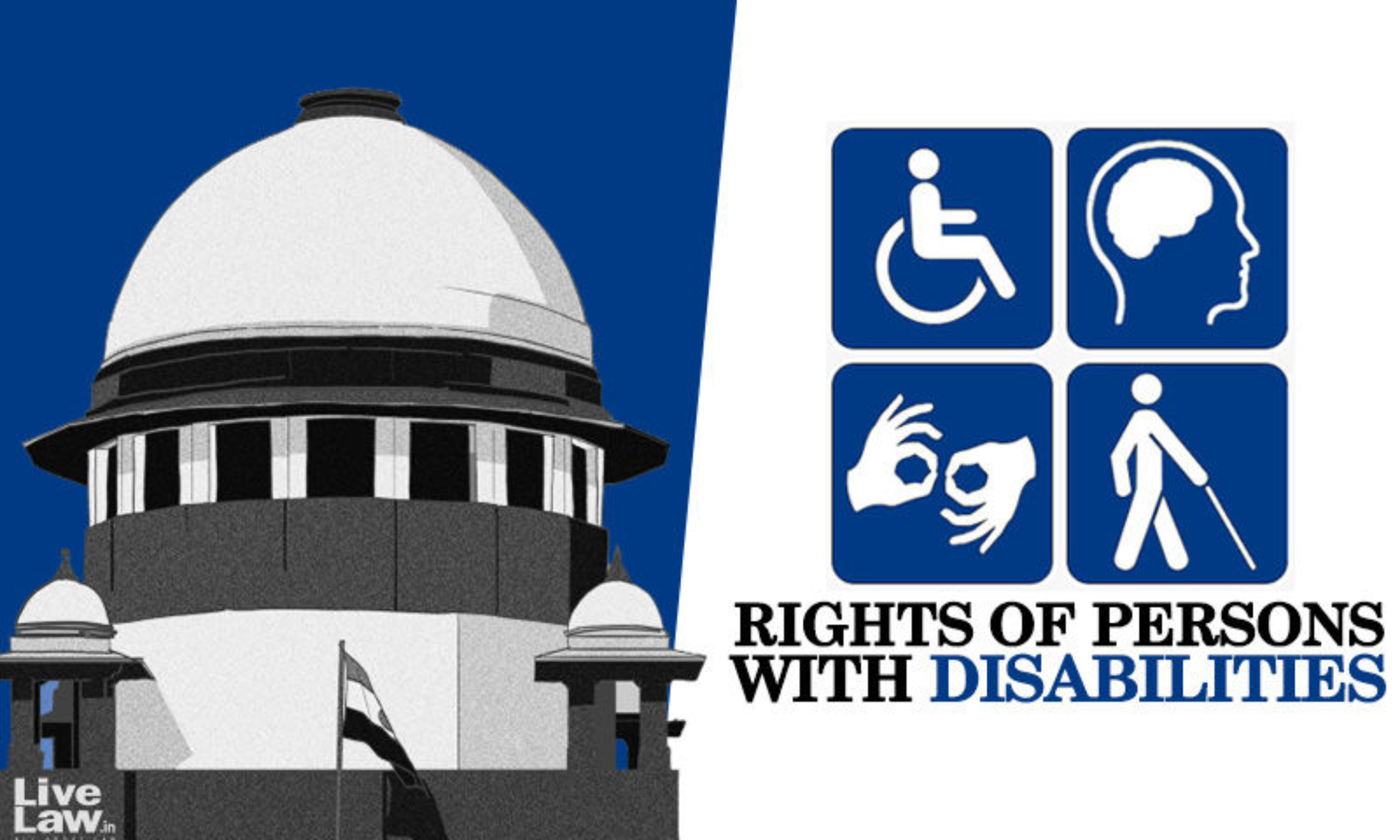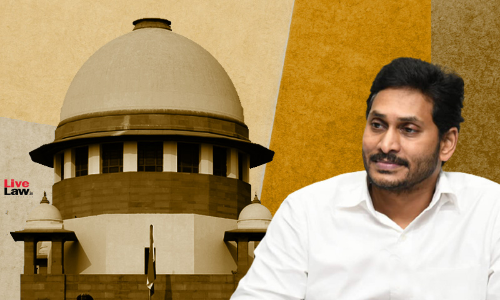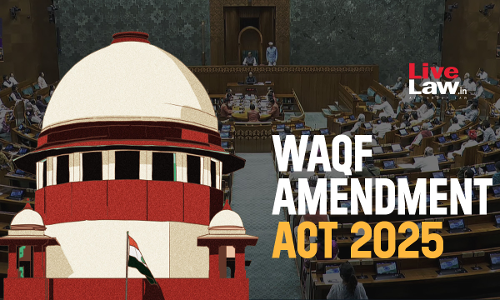Supreme Court's Handbook On Persons With Disabilities Debunks Stereotype-Perpetuating Terms, Advises Judges To Avoid Dehumanising Language

The Chief Justice of India Dr. D.Y. Chandrachud on Saturday(September 28) launched the 'Handbook Concerning Persons with Disabilities' of the Supreme Court of India at the 9th Annual National Consultation Stakeholders Consultation on 'Protecting the Rights of Children Living with Disability and Intersectionality of Disabilities' organised by the Juvenile Justice Committee, Supreme Court of...
The Chief Justice of India Dr. D.Y. Chandrachud on Saturday(September 28) launched the 'Handbook Concerning Persons with Disabilities' of the Supreme Court of India at the 9th Annual National Consultation Stakeholders Consultation on 'Protecting the Rights of Children Living with Disability and Intersectionality of Disabilities' organised by the Juvenile Justice Committee, Supreme Court of India and in association with UNICEF India.
Justice B.V. Nagarathna, Chairman of the Juvenile Justice Committee, who spoke at the event, referred to the judgment of the Supreme Court on disability rights which states: "Language that individualises the impairment and overlooks the disabling social barriers (e.g. terms such as “afflicted”, “suffering”, and “victim”) should be avoided or adequately flagged as contrary to the social model.'
The handbook prepared under the guise of Justice Nagarathna under Part II has dedicated an entire chapter titled 'Language And Disabilities'.
The handbook states: "The language used by judges in their judgments carries immense weight and has the power to shape societal perceptions and attitudes. When it comes to addressing matters involving persons with disabilities, the use of sensitive language is of paramount importance. Judges must be mindful of avoiding dehumanising or demeaning terminology that perpetuates stigma and reinforces negative stereotypes."
This is in line with what Justice Nagarathna stated in her opening address. She said: "Children with disability can face stigma along with negative attitudes that place them at increased risk of violence, neglect abuse and exploitation. Violent forms of discipline can also be given by prevailing attitude towards disability."
Don't use stereotype-perpetuating terms: Handbook
The handbook has suggested that no offensive terms such as "crippled," "idiot," “loony,” “mad,” “junkie,” and “retard” should not be used in any derogatory contexts. Some terms such as “people of determination,” “special,” and “differently abled” are also considered condescending and offensive because they stigmatise the language around disability by substituting it
It states that some term terms that must be avoided while referring to persons with disabilities are: Infirm; Stunted; Unfit; Helpless; Crippled; Defected; Deformed; Invalid; Lame; Maimed; Mutilated; or Subnormal.
Some key terms to avoid when referring to persons with intellectual or learning disabilities or mental health conditions are: Crazy; Freak; Idiot; Insane; Loony; Mad; Maniac; Nut Case; Nuts; Nutter; Psycho; Simpleton; Stupid; or Unhinged.
"When it comes to addressing matters involving persons with disabilities, the use of sensitive language is of paramount importance. Judges must be mindful of avoiding dehumanising or demeaning terminology that perpetuates stigma and reinforces negative stereotypes," the Handbook stated.
Alternative language to be used for persons with disabilities: People-first approach
The handbook states that 'people-first approach' rather than 'identity-first approach' should be employed for persons with disabilities. For instance, 'persons with a disability' is a people-first approach where the individual is recognised and prioritised before the disability.
Examples:'persons with a hearing disability' as opposed to 'hearing disabled person'.
This is in line with the Rights of Persons with Disabilities Act, 2016 in consonance with United Nations Convention on Rights of Persons with Disabilities, 2006.
Alternatively, the handbook suggests that some individuals may prefer or find acceptable an identify-first approach that puts disability first in the description. For instance, 'blind person' instead of 'person with blindness'.
If that is the case, the handbook suggests that when in doubt, best to ask individuals how they wish to identify.
The handbook gives a list of 36 stereotype-perpetuating words and their alternative languages. Some of them are:
1. Abled-bodied/Normal/of sound body and/or mind/typical/whole: persons without disabilities
2. Abnormal atypical: persons with disability or persons with condition/impairment
3. Afflicted by/burdened by/suffering from/stricken by/troubled by/victim of: persons with a disability/condition/impairment; The person has [a disability/condition/impairment]/Person experiences [a disability/condition/impairment].
4. Differently-abled: person with disability/person with [type of condition/impairment].
5. Disabled washroom/handicapped washroom: Accessible washroom
6. Trauma victim: Trauma survivor/ victim (depending on preference)
7. Addict: Person with a substance abuse addiction or condition
8. Alcoholic: Person with an alcohol addiction
9. Crazy/ Insane/Demented/Deranged/Lunatic/Mental/Senile/Unstable/Psychotic: Person with a mental health condition/Person experiencing a mental health condition/Person who has dementia/Alzheimer's disease, or any other clinical condition (where supported by a clinical diagnosis).
10. Inmates or prisoners (of a psychiatric hospital): Patients Clients
What language is to be used for persons with disabilities?
The handbook suggests that judges should employ respectful language which empowers and accurately reflects the lived experience of persons with disabilities.
The handbook has suggested some general guidelines when referring to persons with disabilities, which are:
1. Use of neutral language: Rather than assuming that all persons with disabilities are brave, heroic, inspiring, or suffering, burdened, and victimised, avoid value judgments about the person's experience. Use neutral language to simply state the nature of the disability when relevant to the context. Instead of using weighted terms such as “afflicted by,” or “stricken by,” say “this person has [condition]” instead.
2. Credible diagnosis concerning medical conditions: Do not presume the existence of a medical condition. A diagnosis of a medical condition must be made by a licensed medical or mental health professional. If such confirmation is absent or not possible, use quotes around the term— for instance, “bipolar disorder” or qualifying language such as “is stated to have cerebral palsy” to indicate that no conclusive medical diagnosis exists.
3. Mention a person's disability only if it is relevant to the context: For example, the fact that an individual has a locomotor disability is not relevant to the credibility of their testimony in a case concerning the authenticity of a will. On the other hand, the fact that a witness to a murder, who is being examined for the sole reason that they have seen the murder happen, has a visual impairment will be relevant to determining the value ascribed to the testimony and thus will be mentioned.
4. Avoid identifying someone solely by their disability: Rather than defining or making a disability appear as an essential trait of a person's personality, assume that their disability is one facet of their personality.
5. Ask individuals how they would like to describe their disability: When possible, ask the individual in question how they would prefer to be described. When this is not possible, seek the advice of a trusted family member, caregiver, medical professional, legal representative, or organisation representing the person with disabilities. Persons with disabilities are often bypassed in conversations and the speaker often speaks with their friends or relatives accompanying them. Avoid this tendency and speak with the person directly as far as possible.
6. Be mindful of the diversity among persons with disabilities: The experience of every person with a disability is different. Do not assume that people with the same diagnosis feel similarly about their experiences or the world around them. Like people everywhere, persons with disabilities are a product of their unique, socio-economic and cultural contexts.
7. Be sensitive and try your best: The language around persons with disabilities has evolved considerably over the last century and will continue to do so. In this context, be sensitive to the experience of individuals and be open to learning and unlearning the appropriate language. Certain terms such as “abnormal” and “disorder” which continue to be used in medical contexts should be replaced by alternative terms when describing individuals in non-medical contexts. Make choices about language on a case-by-case basis.
Last year, the Supreme Court released "Handbook on Combating Gender Stereotypes", in order to identify and remove the use of words and phrases, which are loaded with gender stereotypes, in judgments and court language.
This year, the Supreme Court in a significant judgment debunked the use of terms like 'child pornography' and instead suggested that the Court and judgments shall use 'Child Sexual Exploitative & Abuse Material'.
Click Here To Read The Handbook


![Offer Extended Till 15th April! 30% Discount On LiveLaw Academys Judicial Service Examination Preparation Course [Apply Now!] Offer Extended Till 15th April! 30% Discount On LiveLaw Academys Judicial Service Examination Preparation Course [Apply Now!]](https://www.livelaw.in/h-upload/2025/04/12/500x300_595581-lla-early-bird-750-x-450.webp)

